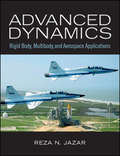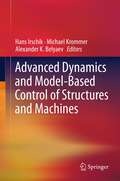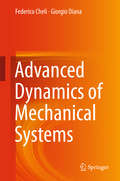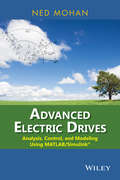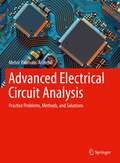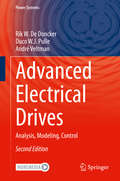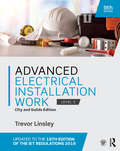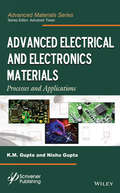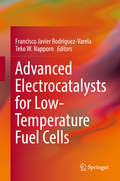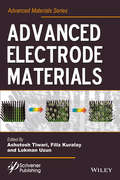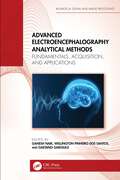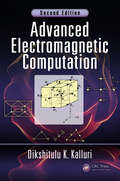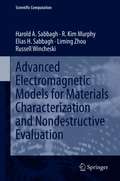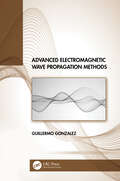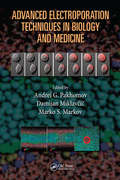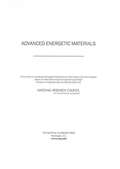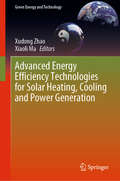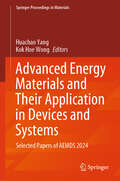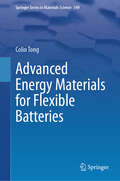- Table View
- List View
Advanced Dynamics
by Reza N. JazarAccording to the author and reviewers, more than 50% of the material taught in courses such as Advanced Dynamics, Mutibody Dynamics, and Spacecraft Dynamics is common to one another. Where graduate students in Mechanical and Aerospace Engineering may have the potential to work on projects that are related to any of the engineering disciplines, they have not been exposed to enough applications in both areas for them to use this information in the real world. This book bridges the gap between rigid body, multibody, and spacecraft dynamics for graduate students and specialists in mechanical and aerospace engineering. The engineers and graduate students who read this book will be able to apply their knowledge to a wide range of applications across different engineering disciplines. The book begins with a review on coordinate systems and particle dynamics which will teach coordinate frames. The transformation and rotation theory along with the differentiation theory in different coordinate frames will provides the required background to learn the rigid body dynamics based on Newton-Euler principles. Applications to this coverage can be found in vehicle dynamics, spacecraft dynamics, aircraft dynamics, robot dynamics, and multibody dynamics, each in a chapter. The Newton equations of motion will be transformed to Lagrange equation as a bridge to analytical dynamics. The methods of Lagrange and Hamilton will be applied on rigid body dynamics. Finally through the coverage of special applications this text provides understanding of advanced systems without restricting itself to a particular discipline. The author will provide a detailed solutions manual and powerpoint slides as ancillaries to this book.
Advanced Dynamics Modeling, Duality and Control of Robotic Systems
by Edward Y.L. GuThis book provides detailed fundamental theoretical reviews and preparations necessary for developing advanced dynamics modeling and control strategies for various types of robotic systems. This research book specifically addresses and discusses the uniqueness issue of representing orientation or rotation, and further proposes an innovative isometric embedding approach. The novel approach can not only reduce the dynamic formulation for robotic systems into a compact form, but it also offers a new way to realize the orientational trajectory-tracking control procedures. In addition, the book gives a comprehensive introduction to fundamentals of mathematics and physics that are required for modeling robot dynamics and developing effective control algorithms. Many computer simulations and realistic 3D animations to verify the new theories and algorithms are included in the book as well. It also presents and discusses the principle of duality involved in robot kinematics, statics, and dynamics. The duality principle can guide the dynamics modeling and analysis into a right direction for a variety of robotic systems in different types from open serial-chain to closed parallel-chain mechanisms. It intends to serve as a diversified research reference to a wide range of audience, including undergraduate juniors and seniors, graduate students, researchers, and engineers interested in the areas of robotics, control and applications.
Advanced Dynamics and Model-Based Control of Structures and Machines
by Alexander K. Belyaev Michael Krommer Hans IrschikThe book contains 26 scientific contributions by leading experts from Russia, Austria, Italy, Japan and Taiwan. It presents an overview on recent developments in Advanced Dynamics and Model Based Control of Structures and Machines. Main topics are nonlinear control of structures and systems, sensing and actuation, active and passive damping, nano- and micromechanics, vibrations and waves.
Advanced Dynamics of Mechanical Systems
by Federico Cheli Giorgio DianaThis book introduces a general approach for schematization of mechanical systems with rigid and deformable bodies. It proposes a systems approach to reproduce the interaction of the mechanical system with different force fields such as those due to the action of fluids or contact forces between bodies, i. e. , with forces dependent on the system states, introducing the concepts of the stability of motion. In the first part of the text mechanical systems with one or more degrees of freedom with large motion and subsequently perturbed in the neighborhood of the steady state position are analyzed. Both discrete and continuous systems (modal approach, finite elements) are analyzed. The second part is devoted to the study of mechanical systems subject to force fields, the rotor dynamics, techniques of experimental identification of the parameters and random excitations. The book will be especially valuable for students of engineering courses in Mechanical Systems, Aerospace, Automation and Energy but will also be useful for professionals. The book is made accessible to the widest possible audience by numerous, solved examples and diagrams that apply the principles to real engineering applications.
Advanced Electric Drives
by Ned MohanWith nearly two-thirds of global electricity consumed by electric motors, it should come as no surprise that their proper control represents appreciable energy savings. The efficient use of electric drives also has far-reaching applications in such areas as factory automation (robotics), clean transportation (hybrid-electric vehicles), and renewable (wind and solar) energy resource management. Advanced Electric Drives utilizes a physics-based approach to explain the fundamental concepts of modern electric drive control and its operation under dynamic conditions. Author Ned Mohan, a decades-long leader in Electrical Energy Systems (EES) education and research, reveals how the investment of proper controls, advanced MATLAB and Simulink simulations, and careful forethought in the design of energy systems translates to significant savings in energy and dollars. Offering students a fresh alternative to standard mathematical treatments of dq-axis transformation of a-b-c phase quantities, Mohan's unique physics-based approach "visualizes" a set of representative dq windings along an orthogonal set of axes and then relates their currents and voltages to the a-b-c phase quantities. Advanced Electric Drives is an invaluable resource to facilitate an understanding of the analysis, control, and modelling of electric machines. * Gives readers a "physical" picture of electric machines and drives without resorting to mathematical transformations for easy visualization * Confirms the physics-based analysis of electric drives mathematically * Provides readers with an analysis of electric machines in a way that can be easily interfaced to common power electronic converters and controlled using any control scheme * Makes the MATLAB/Simulink files used in examples available to anyone in an accompanying website * Reinforces fundamentals with a variety of discussion questions, concept quizzes, and homework problems
Advanced Electrical Circuit Analysis: Practice Problems, Methods, and Solutions
by Mehdi Rahmani-AndebiliThis study guide is designed for students taking advanced courses in electrical circuit analysis. The book includes examples, questions, and exercises that will help electrical engineering students to review and sharpen their knowledge of the subject and enhance their performance in the classroom. Offering detailed solutions, multiple methods for solving problems, and clear explanations of concepts, this hands-on guide will improve student’s problem-solving skills and basic understanding of the topics covered in electric circuit analysis courses.
Advanced Electrical Drives: Analysis, Modeling, Control (Power Systems)
by André Veltman Duco W.J. Pulle Rik W. De DonckerThis book provides a unique approach to derive model-based torque controllers for all types of Lorentz force machines, i.e. DC, synchronous and induction machines. The rotating transformer model forms the basis for the generalized modeling approach of rotating field machines, which leads to the development of universal field-oriented control algorithms. Contrary to this, direct torque control algorithms, using observer-based methods, are developed for switched reluctance machines.Tutorials are included at the end of each chapter, and the reader is encouraged to execute these tutorials in order to gain familiarity with the dynamic behavior of drive systems. This updated edition uses PLECS® simulation and vector processing tools that were specifically adopted for the purpose of these hands-on tutorials. Hence, Advanced Electrical Drives encourages “learning by doing” and the experienced drive specialist may find the simulation tools useful to design high-performance torque controllers. Although it is a powerful reference in its own right, when used in conjunction with the companion texts Fundamentals of Electrical Drives and Applied Control of Electrical Drives, this book provides a uniquely comprehensive reference set that takes readers all the way from understanding the basics of how electrical drives work, to deep familiarity with advanced features and models, to a mastery of applying the concepts to actual hardware in practice. Teaches readers to perform insightful analysis of AC electrical machines and drives;Introduces new modeling methods and modern control techniques for switched reluctance drives;Updated to use PLECS® simulation tools for modeling electrical drives, including new and more experimental results;Numerous tutorials at end of each chapters to learn by doing, step-by-step;Includes extra material featuring “build and play” lab modules, for lectures and self-study.
Advanced Electrical Installation Work 2365 Edition, 8th ed: City and Guilds Edition
by Trevor LinsleyUpdated in line with the 3rd Amendment of the 17th Edition IET Wiring Regulations Amendments, this new edition covers the City and Guilds 2365-03 course. Written in an accessible style with a chapter dedicated to each unit of the syllabus, this book helps you to master each topic before moving on to the next. End of chapter revision questions help you to check your understanding and consolidate the key concepts learned in each chapter. With a brand new website containing videos, animations, worksheets and lesson plans this resource will be invaluable to both students and lecturers alike. The eighth edition contains: Full colour diagrams and photographs to explain difficult concepts Clear definitions of technical terms to make the book a quick and easy reference Extensive online material to help both students and lecturers The companion website material is available at www.routledge.com/cw/linsley
Advanced Electrical Installation Work, 6th ed: City And Guilds Edition
by Trevor LinsleyThis textbook covers all the material you need to pass the first part of the new City & Guilds 2357 Diploma in Electrotechnical Technology. Aligned with the 17th edition IEE Wiring Regulations, this new edition has been thoroughly updated to cover the ‘performance’ section of the latest 2357 course. Written in an accessible style and with a separate chapter for each unit, this book helps you to master each topic before moving on to the next. End of chapter revision questions help you to check your understanding and consolidate the key concepts learned in each chapter. With associated online animations and instructional videos to further support your learning, this is the text that no electrical installations student should be without. Also available: Basic Electrical Installation Work 6th editionTrevor LinsleyISBN: 9780080966281
Advanced Electrical Installation Work: City and Guilds Edition
by Trevor LinsleyThis new edition covers the City and Guilds 2365-03 course, updated in line with the 18th Edition of the Wiring Regulations. Written in an accessible style with a chapter dedicated to each unit of the syllabus, this book helps you to master each topic before moving on to the next. This new edition includes information on construction and demolition sites, fire proofing, energy efficiency and LED lights, as well as some updated diagrams. End of chapter revision questions help you to check your understanding and consolidate the key concepts learned in each chapter. • Full colour diagrams and photographs explain difficult concepts • Clear definitions of technical terms make the book a quick and easy reference • Extensive online material helps both students and lecturers The companion website contains videos, animations, worksheets and lesson plans, making it an invaluable resource to both students and lecturers alike. www.routledge.com/cw/linsley
Advanced Electrical and Electronics Materials: Processes and Applications (Advanced Material Series)
by Ashutosh Tiwari Nishu Gupta K. M. GuptaThis comprehensive and unique book is intended to cover the vast and fast-growing field of electrical and electronic materials and their engineering in accordance with modern developments. Basic and pre-requisite information has been included for easy transition to more complex topics. Latest developments in various fields of materials and their sciences/engineering, processing and applications have been included. Latest topics like PLZT, vacuum as insulator, fiber-optics, high temperature superconductors, smart materials, ferromagnetic semiconductors etc. are covered. Illustrations and examples encompass different engineering disciplines such as robotics, electrical, mechanical, electronics, instrumentation and control, computer, and their inter-disciplinary branches. A variety of materials ranging from iridium to garnets, microelectronics, micro alloys to memory devices, left-handed materials, advanced and futuristic materials are described in detail.
Advanced Electrocatalysts for Low-Temperature Fuel Cells
by Francisco Javier Rodríguez-Varela Teko W. NappornThis book introduces the reader to the state of the art in nanostructured anode and cathode electrocatalysts for low-temperature acid and alkaline fuel cells. It explores the electrocatalysis of anode (oxidation of organic molecules) and cathode (oxygen reduction) reactions. It also offers insights into metal-carbon interactions, correlating them with the catalytic activity of the electrochemical reactions. The book explores the electrocatalytic behaviour of materials based on noble metals and their alloys, as well as metal-metal oxides and metal-free nanostructures. It also discusses the surface and structural modification of carbon supports to enhance the catalytic activity of electrocatalysts for fuel-cell reactions.
Advanced Electrochemical Materials in Energy Conversion and Storage (Emerging Materials and Technologies)
by Junbo HouAdvanced Electrochemical Materials in Energy Conversion and Storage focuses on novel electrochemical materials particularly designed for specific energy applications. It presents the relationship of materials properties, state-of-the-art processing, and device performance and sheds light on the research, development, and deployment (RD&D) trend of emerging materials and technologies in this field. Emphasizes electrochemical materials applied in PEM fuel cells and water splitting Summarizes anode, cathode, electrolyte, and additive materials developed for lithium-ion batteries and reviews other batteries, including lithium air, lithium sulfur, sodium and potassium, and multivalent ion batteries Discusses advanced carbon materials for supercapacitors Highlights catalyst design and development for CO2RR and fundamentals of proton facilitated reduction reactions With a cross-disciplinary approach, this work will be of interest to scientists and engineers across chemical engineering, mechanical engineering, materials science, chemistry, physics, and other disciplines working to advance electrochemical energy conversion and storage capabilities and applications.
Advanced Electrode Materials (Advanced Material Series)
by Ashutosh Tiwari Lokman Uzun Filiz KuralayThis book covers the recent advances in electrode materials and their novel applications at the cross-section of advanced materials. The book is divided into two sections: State-of-the-art electrode materials; and engineering of applied electrode materials. The chapters deal with electrocatalysis for energy conversion in view of bionanotechnology; surfactant-free materials and polyoxometalates through the concepts of biosensors to renewable energy applications; mesoporous carbon, diamond, conducting polymers and tungsten oxide/conducting polymer-based electrodes and hybrid systems. Numerous approaches are reviewed for lithium batteries, fuel cells, the design and construction of anode for microbial fuel cells including phosphate polyanion electrodes, electrocatalytic materials, fuel cell reactions, conducting polymer based hybrid nanocomposites and advanced nanomaterials.
Advanced Electroencephalography Analytical Methods: Fundamentals, Acquisition, and Applications (Biomedical Signal and Image Processing)
by Ganesh Naik Santos, Wellington Pinheiro dos Gaetano GargiuloAdvanced Electroencephalography Analytical Methods: Fundamentals, Acquisition, and Applications presents the theoretical basis and applications of electroencephalography (EEG) signals in neuroscience, involving signal analysis, processing, signal acquisition, representation, and applications of EEG signal analysis using non-linear approaches and machine learning. It explains principles of neurophysiology, linear signal processing, computational intelligence, and the nature of signals including machine learning. Applications involve computer-aided diagnosis, brain-computer interfaces, rehabilitation engineering, and applied neuroscience.This book: Includes a comprehensive review on biomedical signals nature and acquisition aspects. Focuses on selected applications of neuroscience/cardiovascular/muscle-related biomedical areas. Provides a machine learning update to a classical biomedical signal processing approach. Explains deep learning and application to biomedical signal processing and analysis. Explores relevant biomedical engineering and neuroscience state-of-the-art applications. This book is intended for researchers and graduate students in biomedical signal processing, electrical engineering, neuroscience, and computer science.
Advanced Electromagnetic Computation
by Dikshitulu K. KalluriAdvanced Electromagnetic Computation with MATLAB® discusses commercial electromagnetic software, widely used in the industry. Algorithms of Finite Differences, Moment method, Finite Element method and Finite Difference Time Domain method are illustrated. Hand-computed simple examples and MATLAB-coded examples are used to explain the concepts behind the algorithms. Case studies of practical examples from transmission lines, waveguides, and electrostatic problems are given so students are able to develop the code and solve the problems. Two new chapters including advanced methods based on perturbation techniques and three dimensional finite element examples from radiation scattering are included.
Advanced Electromagnetic Models for Materials Characterization and Nondestructive Evaluation (Scientific Computation)
by Elias H. Sabbagh Harold A Sabbagh R. Kim Murphy Liming Zhou Russell WincheskiThis book expands on the subject matter of ’Computational Electromagnetics and Model-Based Inversion: A Modern Paradigm for Eddy-Current Nondestructive Evaluation.’ It includes (a) voxel-based inversion methods, which are generalizations of model-based algorithms; (b) a complete electromagnetic model of advanced composites (and other novel exotic materials), stressing the highly anisotropic nature of these materials, as well as giving a number of applications to nondestructive evaluation; and (c) an up-to-date discussion of stochastic integral equations and propagation-of-uncertainty models in nondestructive evaluation. As such, the book combines research started twenty-five years ago in advanced composites and voxel-based algorithms, but published in scattered journal articles, as well as recent research in stochastic integral equations. All of these areas are of considerable interest to the aerospace, nuclear power, civil infrastructure, materials characterization and biomedical industries. The book covers the topic of computational electromagnetics in eddy-current nondestructive evaluation (NDE) by emphasizing three distinct topics: (a) fundamental mathematical principles of volume-integral equations as a subset of computational electromagnetics, (b) mathematical algorithms applied to signal-processing and inverse scattering problems, and (c) applications of these two topics to problems in which real and model data are used. It is therefore more than an academic exercise and is valuable to users of eddy-current NDE technology in industries as varied as nuclear power, aerospace, materials characterization and biomedical imaging.
Advanced Electromagnetic Wave Propagation Methods
by Guillermo GonzalezThis textbook provides a solid foundation into many approaches that are used in the analysis of advanced electromagnetic wave propagation problems. The techniques discussed are essential to obtain closed-form solutions or asymptotic solutions and meet an existing need for instructors and students in electromagnetic theory. The book covers various advanced mathematical methods used in the evaluation of the electromagnetic fields in rectangular, cylindrical and spherical geometries. The mathematics of special functions (i.e., Bessel, Hankel, Airy, Legendre, Error, etc.) are covered in depth, including appropriate Appendices. The author takes particular care to provide detailed explanations of auxiliary potentials, Hertz’s vectors, Debye potentials, as well as the use of Green functions, the Watson transformation and the method of steepest descent in the solution of electromagnetic problems. Overall, Advanced Electromagnetic Wave Propagation Methods is a good source for the many skills required in obtaining closed form and asymptotic solution, which in many instances cannot be obtained using computer codes of Maxwell’s equations. Thus, it provides an excellent training for preparing graduate students in their research work. This book is intended for a graduate course in electromagnetic theory for students in electrical engineering. Students in physics and professionals will also find it appropriate and useful. Provides a comprehensive and unified treatment of radiation and propagation problems Presents a detailed explanation in the use of Green functions, the Watson transformation and the method of steepest descent as they apply to electromagnetic problems Demonstrates various advanced mathematical techniques used in the evaluation of the electromagnetic fields Details how to formulate and obtain a closed-form solution or an asymptotic solution Includes appendices for Bessel, Legendre, Airy and Error functions
Advanced Electromagnetics and Scattering Theory
by Kasra Barkeshlisina KhorasaniThis book present the lecture notes used in two courses that the late Professor Kasra Barkeshli had offered at Sharif University of Technology, namely, Advanced Electromagnetics and Scattering Theory. The prerequisite for the sequence is vector calculus and electromagnetic fields and waves. Some familiarity with Green's functions and integral equations is desirable but not necessary. The book provides a brief but concise introduction to classical topics in the field. It is divided into three parts including annexes. Part I covers principle of electromagnetic theory. The discussion starts with a review of the Maxwell's equations in differential and integral forms and basic boundary conditions. The solution of inhomogeneous wave equation and various field representations including Lorentz's potential functions and the Green's function method are discussed next. The solution of Helmholtz equation and wave harmonics follow. Next, the book presents plane wave propagation in dielectric and lossy media and various wave velocities. This part concludes with a general discussion of planar and circular waveguides. Part II presents basic concepts of electromagnetic scattering theory. After a brief discussion of radar equation and scattering cross section, the author reviews the canonical problems in scattering. These include the cylinder, the wedge and the sphere. The edge condition for the electromagnetic fields in the vicinity of geometric discontinuities are discussed. The author also presents the low frequency Rayleigh and Born approximations. The integral equation method for the formulation of scattering problems is presented next, followed by an introduction to scattering from periodic structures. Part III is devoted to numerical methods. It begins with finite-difference methods to solve elliptic equations, and introduces the finite-difference time-domain method for the solution of hyperbolic and parabolic equations. Next, the part turns to the method of moments for the solution of integral equations. This part ends with a short introduction to the finite-element method.
Advanced Electroporation Techniques in Biology and Medicine (Biological Effects of Electromagnetics)
by Marko S. Markov Andrei G. Pakhomov Damijan MiklavcicA reflection of the intense study of the effects of electromagnetic fields on living tissues that has taken place during the last decades, Advanced Electroporation Techniques in Biology and Medicine summarizes most recent experimental findings and theories related to permeabilization of biomembranes by pulsed electric fields. Edited by experts and
Advanced Energetic Materials
by Committee on Advanced Energetic Materials Manufacturing TechnologiesAdvanced energetic materials—explosive fill and propellants—are a critical technology for national security. While several new promising concepts and formulations have emerged in recent years, the Department of Defense is concerned about the nation’s ability to maintain and improve the knowledge base in this area. To assist in addressing these concerns, two offices within DOD asked the NRC to investigate and assess the scope and health of the U.S. R&D efforts in energetic materials. This report provides that assessment. It presents several findings about the current R&D effort and recommendations aimed at improving U.S. capabilities in developing new energetic materials technology. This study reviewed U.S. research and development in advanced energetics being conducted by DoD, the DoE national laboratories, industries, and academia, from a list provided by the sponsors. It also: (a) reviewed papers and technology assessments of non-U.S. work in advanced energetics, assessed important parameters, such as validity, viability, and the likelihood that each of these materials can be produced in quantity; (b) identified barriers to scale-up and production, and suggested technical approaches for addressing potential problems; and (c) suggested specific opportunities, strategies, and priorities for government sponsorship of technologies and manufacturing process development.
Advanced Energy Efficiency Technologies for Solar Heating, Cooling and Power Generation (Green Energy and Technology)
by Xudong Zhao Xiaoli MaThis book, based on the research experience and outcomes of a group of international contributors, addresses a range of advanced energy efficiency technologies and their applications in solar heating, cooling and power generation, while also providing solutions for tackling recurring low efficiency problems in today’s systems. It highlights the latest technologies and methods, which can significantly improve the performance of solar systems, enabling readers to design, construct and apply high-performance solar systems in or for their own projects. The contributors provide a systematic introduction to state-of-the-art energy efficiency technologies that demonstrates how to implement innovative solar systems. These technologies include: • heat pipes and loop heat pipes; • phase change materials (PCMs) and PCM slurries; • micro-channel panels; • desiccant/adsorption cycling; • ejector cooling and heat pumps; and • solar concentration and thermoelectric units. The book shows how innovative solar systems applicable to rural and urban buildings can be analysed and demonstrates the successful implementation of these advanced technologies. It delivers the design principles and associated energy performance assessment methods for a range of selected solar heating, cooling and power generation projects. This book offers a valuable source of information for final-year undergraduate students, as well as graduate students and academic lecturers, as it promotes the widespread deployment of advanced solar heating, cooling and power generation technologies applicable for buildings across the globe. The book is also a good point of reference for design engineers and energy consultants who wish to extend their knowledge of advanced technologies used to achieve energy efficiency.
Advanced Energy Materials
by Ashutosh Tiwari Sergiy ValyukhAn essential resource for scientists designing new energy materials for the vast landscape of solar energy conversion as well as materials processing and characterizationBased on the new and fundamental research on novel energy materials with tailor-made photonic properties, the role of materials engineering has been to provide much needed support in the development of photovoltaic devices. Advanced Energy Materials offers a unique, state-of-the-art look at the new world of novel energy materials science, shedding light on the subject's vast multi-disciplinary approachThe book focuses particularly on photovoltaics, efficient light sources, fuel cells, energy-saving technologies, energy storage technologies, nanostructured materials as well as innovating materials and techniques for future nanoscale electronics. Pathways to future development are also discussed.Critical, cutting-edge subjects are addressed, including:Non-imaging focusing heliostat; state-of-the-art of nanostructuresMetal oxide semiconductors and their nanocompositesSuperionic solids; polymer nanocomposites; solid electrolytes; advanced electronicsElectronic and optical properties of lead sulfideHigh-electron mobility transistors and light-emitting diodesAnti-ferroelectric liquid crystals; PEEK membrane for fuel cellsAdvanced phosphors for energy-efficient lightingMolecular computation photovoltaics and photocatalystsPhotovoltaic device technology and non-conventional energy applicationsReadershipThe book is written for a large and broad readership including researchers and university graduate students from diverse backgrounds such as chemistry, materials science, physics, and engineering working in the fields of nanotechnology, photovoltaic device technology, and non-conventional energy.
Advanced Energy Materials and Their Application in Devices and Systems: Selected Papers of AEMDS 2024 (Springer Proceedings in Materials #62)
by Huachao Yang Kok Hoe WongThis book provides insights into cutting-edge developments in energy materials, devices, and systems, as presented at the International Conference on Advanced Energy Materials, Devices, and Systems (AEMDS 2024) in Ningbo, China, from June 28 to 29, 2024. Focusing on the global demand for high-performance energy storage devices, the conference explores advancements in materials crucial for their development. AEMDS 2024 serves as a platform for discussions on experimental breakthroughs, ongoing developments, and practical applications in the field. Keynote and invited speakers from the global energy domain contribute to a dynamic exchange of ideas, promoting a deeper understanding of emerging energy materials and their applications across various research fields.
Advanced Energy Materials for Flexible Batteries (Springer Series in Materials Science #349)
by Colin TongThis book provides a comprehensive guide to the cutting-edge science and engineering behind the development of flexible batteries. These innovative devices, capable of bending, twisting, and stretching, hold immense potential for applications ranging from wearable electronics to large-scale energy storage systems. The book presents a thorough overview of the essential materials and design principles that underpin flexible battery technology. It explores the latest advancements in electrode materials, electrolytes, and separators, focusing on materials that exhibit exceptional flexibility, high energy density, and excellent rate capability. In addition to materials selection, the book addresses the challenges and opportunities associated with designing and manufacturing flexible batteries. It discusses strategies for creating flexible battery cells that can withstand mechanical deformation, as well as efficient manufacturing processes and performance evaluation methods. By offering a deep understanding of the materials science and engineering principles governing flexible batteries, this book aims to inspire further research and development in this rapidly evolving field. This book is an essential resource for engineers and materials scientists involved in battery development.
